AUDI TT ROADSTER 2018 Owners Manual
Manufacturer: AUDI, Model Year: 2018, Model line: TT ROADSTER, Model: AUDI TT ROADSTER 2018Pages: 310, PDF Size: 46.95 MB
Page 251 of 310
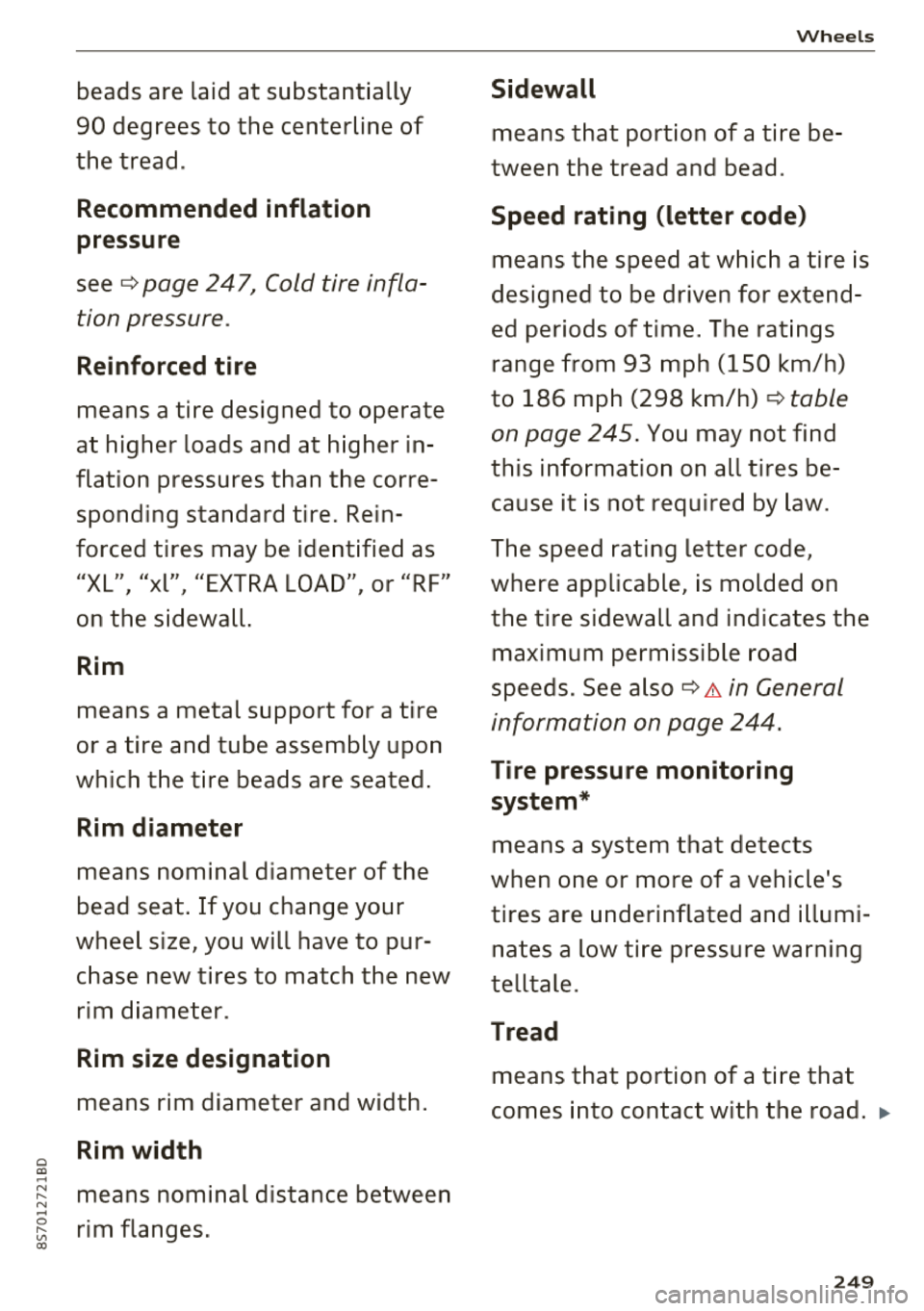
0 co .... N
" N .... 0
" "' co
beads are laid at substantially
90 degrees to the centerline of
the tread .
Recommended inflation
pressure
see ¢ page 247, Cold tire infla
tion pressure .
Reinforced tire
means a tire designed to operate
at higher loads and at h igher in
flation pressures than the corre
sponding standard tire. Rein
forced tires may be identified as
"XL", "xl", "EXT RA L OAD", or "RF"
on the sidewa ll.
Rim
means a metal support for a tire
or a tire and tube assemb ly upon
which the t ire beads are seated .
Rim diameter
means nominal diameter of the
bead seat . If you change your
whee l size, you will have to pu r
c h ase new t ires to match the new
rim diameter .
Rim size designation
means rim diamete r and width .
Rim width
means nominal distance between
rim flanges .
Wheels
Sidewall
means that portion of a tire be
tween the tread and bead .
Speed rating (letter code)
means the speed at which a tire is
designed to be driven for extend
ed periods of time. The ra tings
range from
93 mph (150 km/h)
to
186 mph (298 km/h) ¢ table
on page 245 .
You may not find
this informat ion on all tires be
cause it is not required by law .
The speed rating letter code,
where applicable, is molded on
the tire sidewall and indicates t he
maximum pe rmissible roa d
speeds . See also ¢
A in General
information on page 244.
Tire pressure monitoring
system *
means a system that detects
when one or more of a vehicle's
ti res are underinflated and illumi
nates a low tire pressure warning
telltale .
Tread
means that portion of a ti re that
comes into contact with the road .
.,.
249
Page 252 of 310
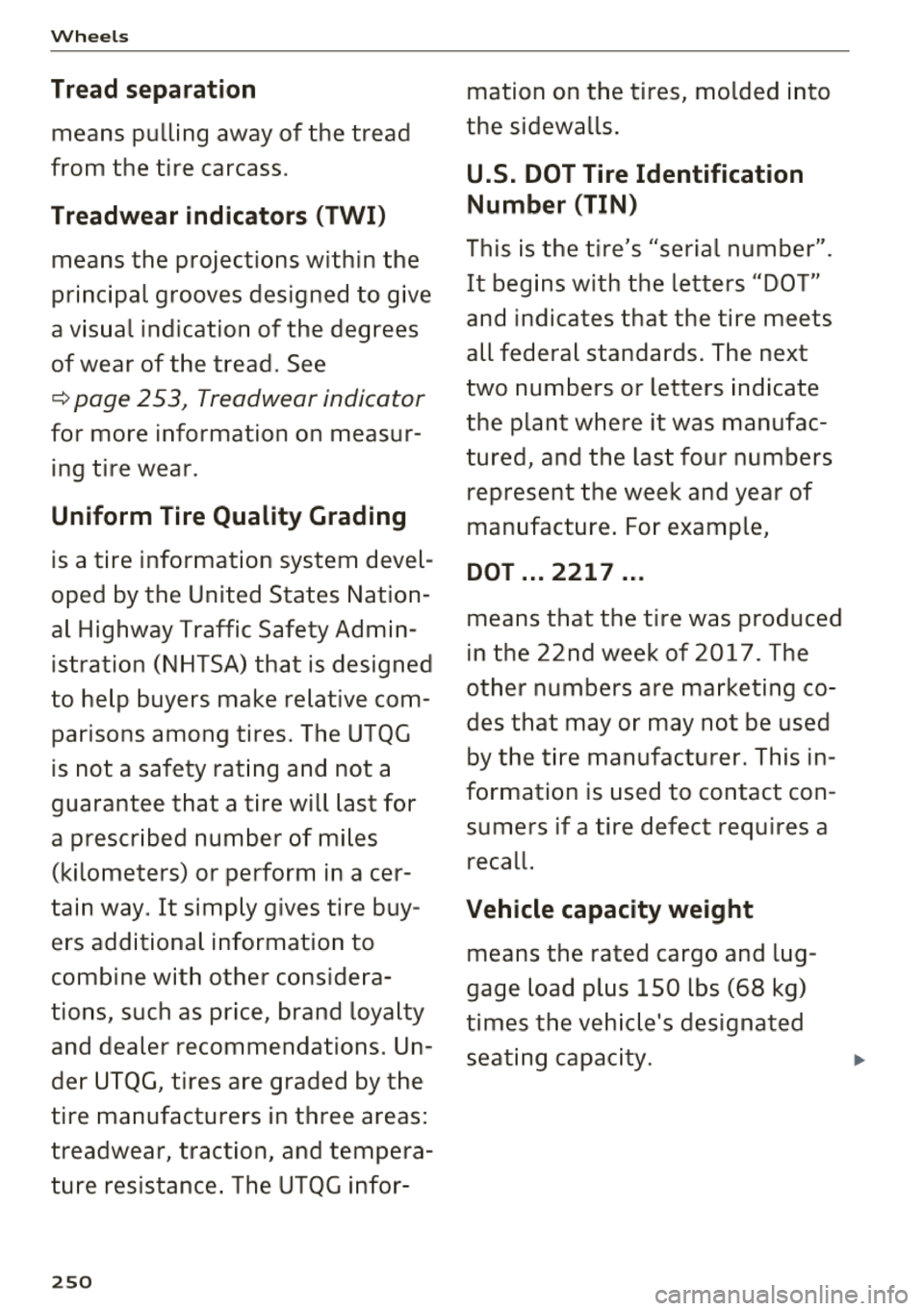
Wheel s
Tread separation
means pulling away of the tread
from the tire carcass .
Treadwear indicators (TWI)
means the projections within the
principal grooves designed to give
a visual indication of the degrees
of wear of the tread . See
~ page 253, Treadwear indicator
for more information on measur
ing tire wear .
Uniform Tire Quality Grading
is a tire information system devel
oped by the United States Nation
al Highway Traffic Safety Admin
istration (NHTSA) that is designed
to help buyers make relat ive com
parisons among tires. The UTQG
is not a safety rat ing and not a
guarantee that a tire will last for
a prescr ibed number of miles
( kilometers) or perform in acer
tain way . It simply gives tire buy
ers additional information to
combine with other considera
tions, such as price, brand loyalty
and dealer recommendations . Un
der UTQG, t ires are graded by the
tire manufacturers in three areas:
treadwear, traction, and tempera
ture resistance . The UTQG infor -
250
mation on the tires , molded into
the sidewalls .
U.S. DOT Tire Identification
Number (TIN )
This is the tire's "serial number".
It begins with the letters
"DOT"
and indicates that the tire meets
all federal standards. The next
two numbers or letters indicate
the plant where it was manufac tured, and the last four numbers
represent the week and year of
manufacture . Fo r example,
DOT ... 2217 ...
means that the tire was produced
in the 22nd week of 2017. The
other numbers are marketing co
des that may or may not be used by the tire manufacturer. This in
formation is used to contact con
sumers if a tire defect requires a recall.
Veh icle capac ity weight
means the rated cargo and lug
gage load plus 150 lbs (68 kg)
times the veh icle's designated
seating capacity.
Page 253 of 310
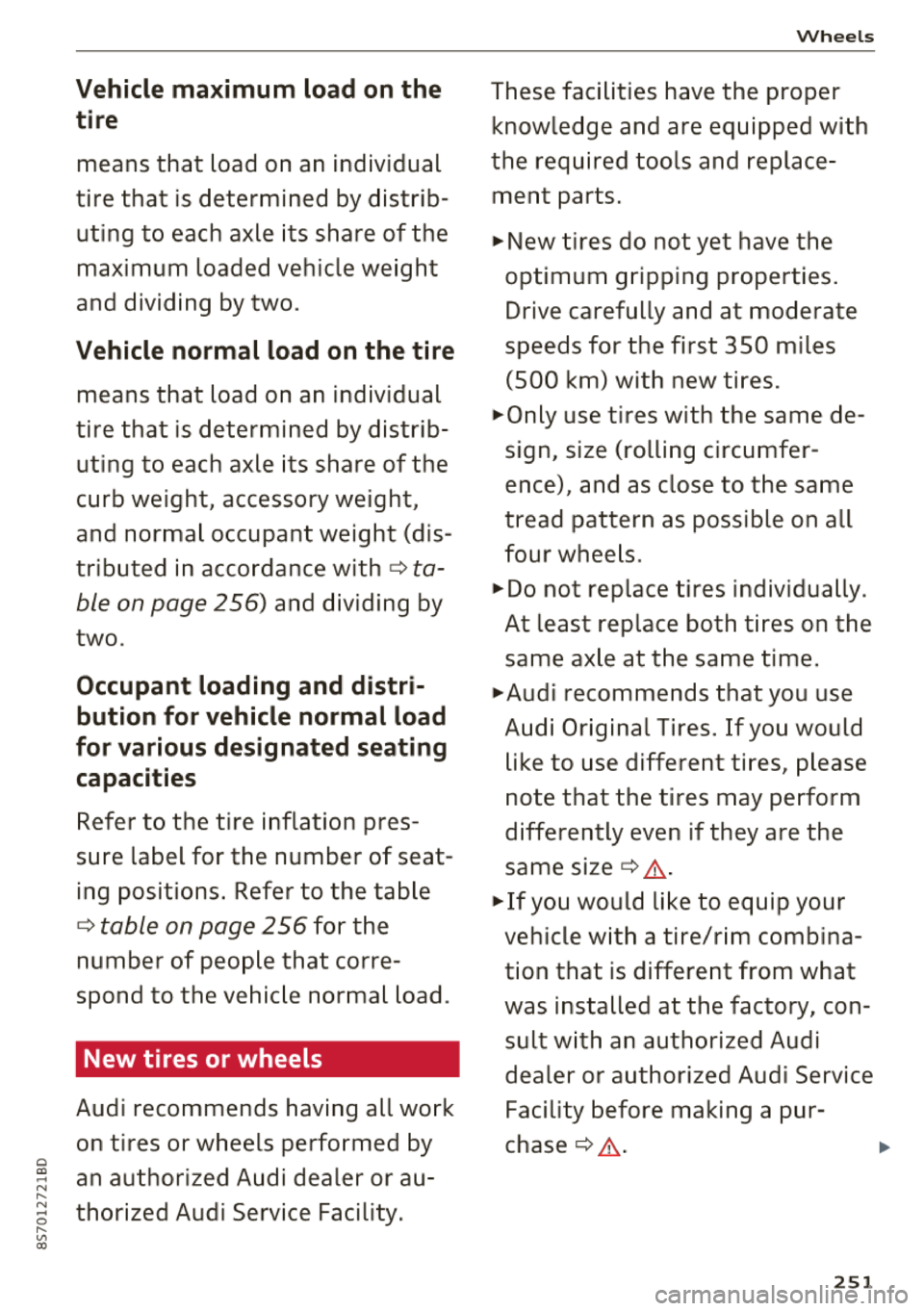
0
Vehicle maximum load on the
tire
means that load on an individual
tire that is determined by distrib
uting to each axle its share of the
maximum loaded vehic le we ight
and dividing by two .
Vehicle normal load on the tire
means that load on an individual
tire that is determined by distrib
uting to each axle its share of the
curb weight, accessory weight,
and normal occupant weight (dis
tributed in accordance
with ¢ ta
ble on page 256)
and dividing by
two .
Occupant loading and distri
bution for vehicle normal load
for various designated seating
capacities
Refer to the tire inflation pres
sure label for the number of seat
ing positions . Refer to the tab le
¢
table on page 256 for the
number of people that corre
spond to the vehic le normal load .
New tires or wheels
Audi recommends having all wo rk
on t ires or wheels performed by
~ an authorized Audi dealer or au-N
" ~ thorized Audi Service Facility. 0
" "' a:,
Wh eel s
These facilities have the proper
knowledge and are equipped with
the required tools and replace ment parts.
.,. New tires do not yet have the
optimum g ripping properties.
Drive carefully and at moderate
speeds for the first 350 miles
(500 km) with new tires .
i,.Qnly use tires w ith the same de
sign, size (rolling circumfer
ence), and as close to the same
tread pattern as possible on all
four whee ls .
.,. Do not replace tires individually .
At least replace both tires on the
same axle at the same t ime.
.,. Audi recommends that you use
Audi Original Tires. If you would
like to use different tires , please
note that the tires may perform
differently even if they are the
same size
¢ ,& .
.,. If you would like to equip your
vehic le w ith a tire/r im combina
tion that is different from what
was installed at the factory, con
sult w ith an authorized Audi
dealer or authorized Audi Service
Facility before making a pur-
chase¢ ,&.. .,.
25 1
Page 254 of 310
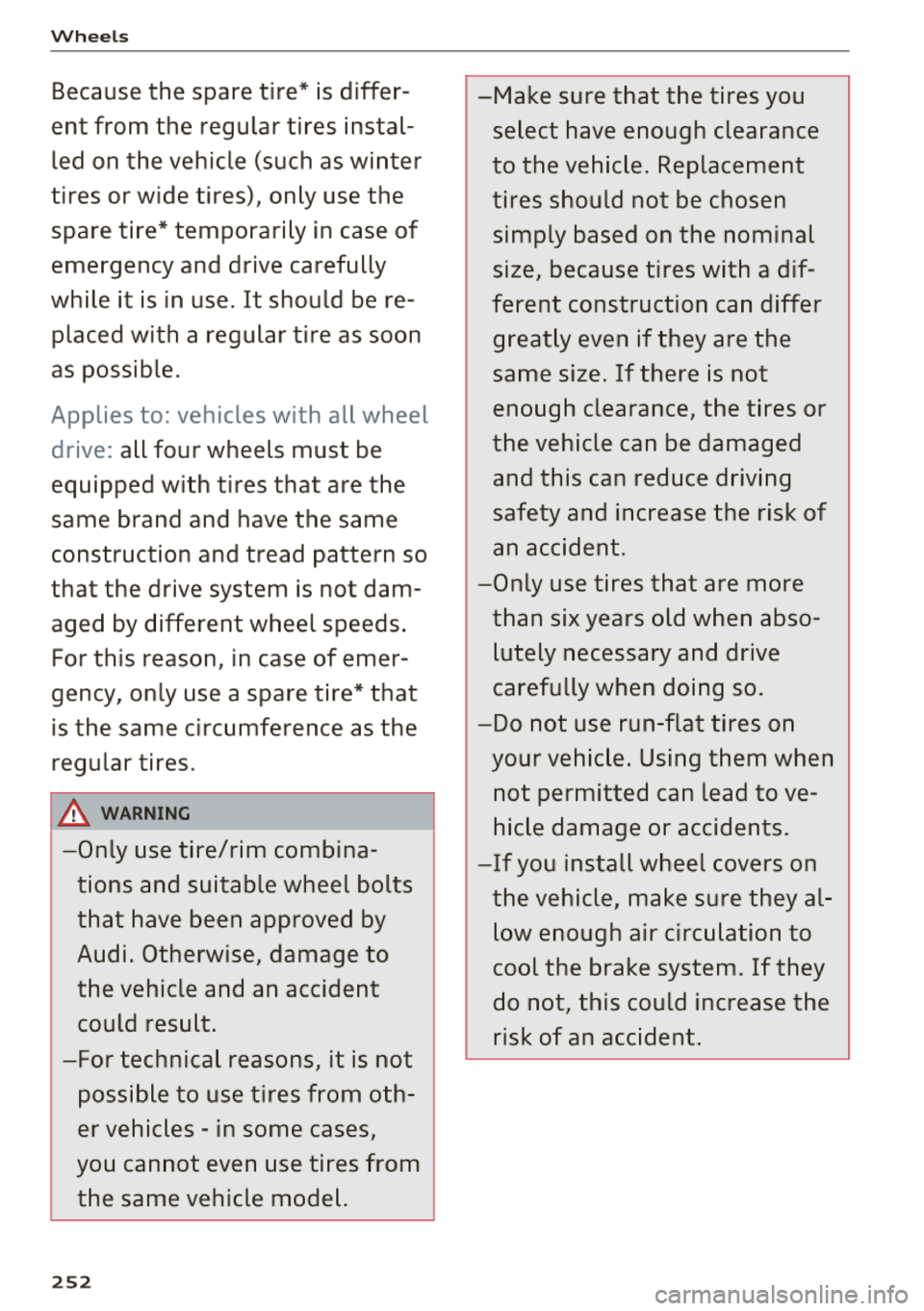
Wheels
Because the spare tire* is differ
ent from the regular tires instal led on the vehicle (such as winter
tires or wide tires), only use the
spare tire* temporarily in case of
emergency and drive carefully
while it is in use. It should be re placed with a regular tire as soon
as possible.
Applies to: vehicles with all wheel
drive: all four wheels must be
equipped with tires that are the
same brand and have the same
construction and tread pattern so
that the drive system is not dam
aged by different wheel speeds.
For this reason, in case of emer
gency, only use a spare tire* that
is the same circumference as the
regular tires.
& WARNING ~ -
-Only use tire/rim combina
tions and suitable wheel bolts
that have been approved by
Audi. Otherwise, damage to
the vehicle and an accident could result.
-For technical reasons, it is not
possible to use tires from oth
er vehicles - in some cases,
you cannot even use tires from
the same vehicle model.
252
-Make sure that the tires you
select have enough clearance
to the vehicle. Replacement
tires should not be chosen simply based on the nominal
size, because tires with a dif
ferent construction can differ greatly even if they are the
same size. If there is not
enough clearance, the tires or
the vehicle can be damaged and this can reduce driving
safety and increase the risk of
an accident.
-Only use tires that are more
than six years old when abso
lutely necessary and drive
carefully when doing so.
-Do not use run-flat tires on
your vehicle. Using them when not permitted can lead to ve
hicle damage or accidents.
- If you install wheel covers on
the vehicle, make sure they al low enough air circulation to
cool the brake system. If they
do not, this could increase the
risk of an accident.
Page 255 of 310
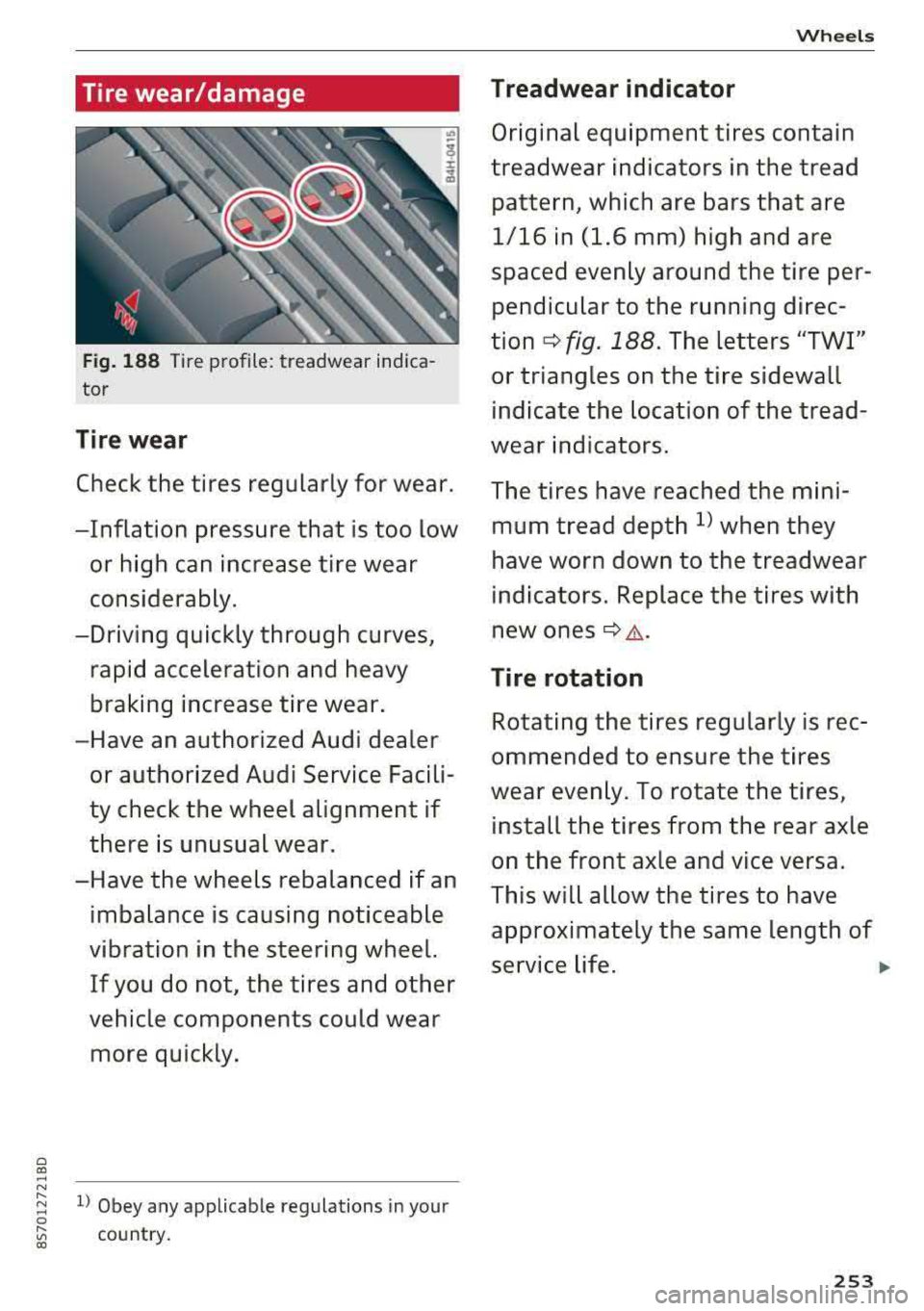
0 a, .... N
Tire wear/damage
Fig. 188 Tire profile: treadwear indica
tor
Tire wear
Check the tires regular ly for wear.
-Inflation pressure that is too low
or high can increase tire wear
considerably.
-Driving quickly through curves, rapid acceleration and heavy
braking increase tire wear.
-Have an authorized Audi dea ler
or authorized Audi Service Facili
ty check the wheel alignment if
there is unusual wear.
-Have the wheels rebalanced if an imbalance is causing noticeable
vibration in the steering wheel.
If you do not, the tire s and other
vehicle components could wear more quickly.
~ l) Obey any applicable regulations in your 0
[;:; country. 00
Wheels
Treadwear indicator
Original equipment tires contain
treadwear indicators in the tread
pattern, which are bars that are 1/16 in (1.6 mm) high and are
spaced evenly around the tire per pendicular to the running direc
tion
c:> fig. 188. The letters "TWI"
or triangles on the tire sidewall indicate the location of the tread
wear indicators.
The tires have reached the mini
mum tread depth
l) when they
have worn down to the treadwear
indicators. Replace the tires with
new ones
c:> ..1,,. .
Tire rotation
Rotating the tires regularly is rec
ommended to ensure the tires
wear evenly. To rotate the tires, install the tires from the rear axle
on the front axle and vice versa.
This w ill allow the tires to have
approximately the same length of
service life.
..,.
253
Page 256 of 310
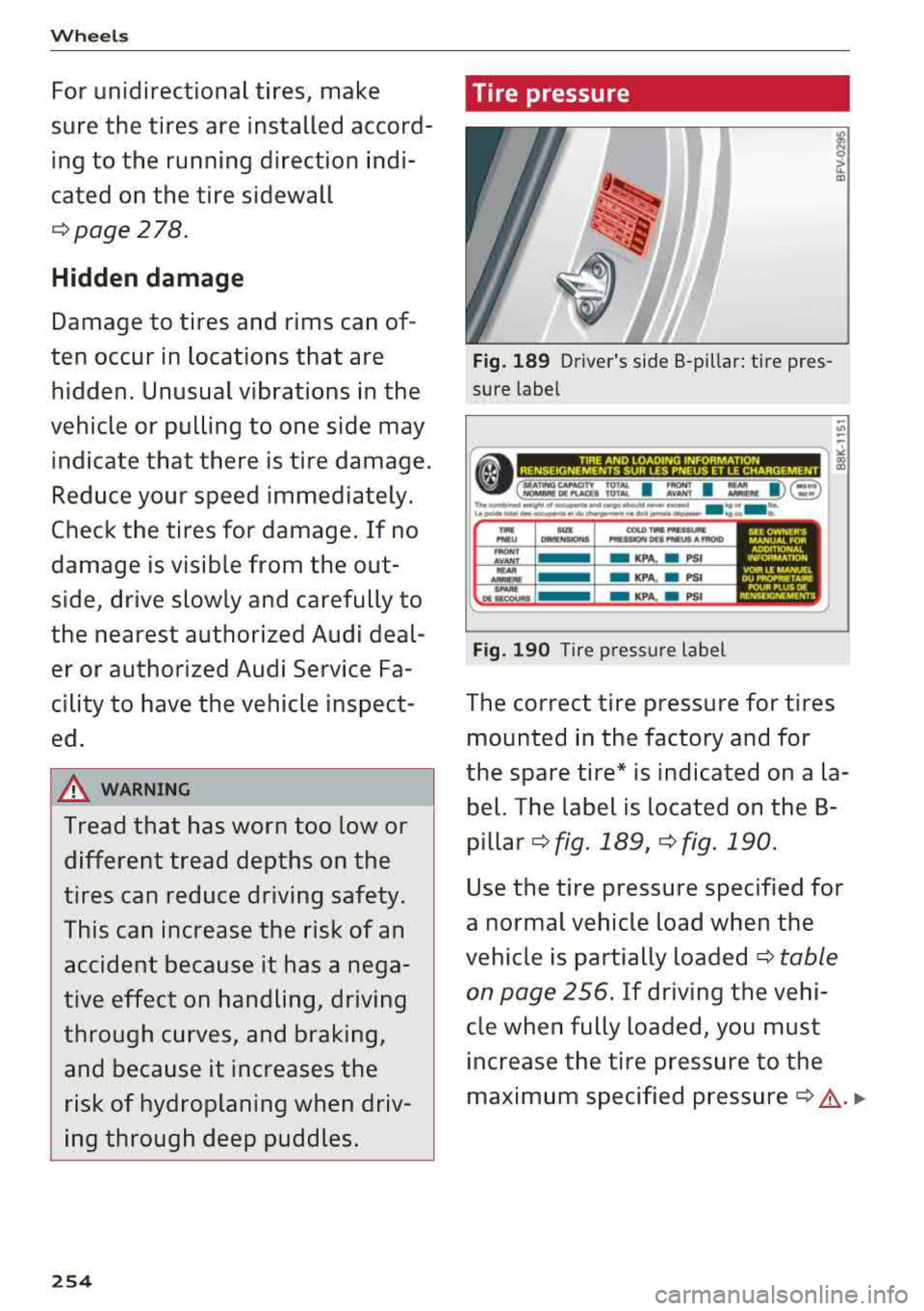
Wheels
For unidirectional tires, make
sure the tires are installed a ccord
ing to the running direction indi
cated on the tire sidewall
¢ page 278.
Hidden damage
Damage to tires and rims can of
ten occur in locations that are
hidden. Unusual vibrations in the
vehicle or pulling to one side may indicate that there is tire damage.
Reduce your speed immediately.
Check the tires for damage. If no
damage is visible from the out
side, drive slowly and carefully to
the nearest authorized Audi deal
er or authorized Audi Service Fa
cility to have the vehicle inspect
ed.
_& WARNING i-==
Tread that has worn too low or different tread depths on the
tires can reduce dr iving safety.
This can increase the risk of an
accident because it has a nega
t ive effect on handling, driving
through curves, and braking,
and because it increases the
risk of hydroplaning when driv
ing through deep puddles.
254
-
Tire pressure
Fig. 189 Driver's side 8-p illar: t ire pres
sure label
"'
8 > ...
"'
"' -
a "
fl ( =::~ m:t I =: I :=... I ) (: ::-) ~ Tbe..,_.....,..._....,_..,...,..~----. ... _ ... ........ wia1-.-. ......... *'~""'-,-......., ..... lb-
llN! IIZli COlD 111111! MCSIUM. NU ON(HA)!Q "'"510NOU,....,. AM)O
"'"'" v - KP aPSI
Fig. 190 Tire pr ess u re lab el
i.tE OWNUrS MANUAL fOR ADDmoNA.l INFORMATION VO" l£ M~U'[L DV ,ROPIQETAIRE POUR PLUS Of IIIEr-lSEIG~MCNTS
The correct tire pressure for tires
mounted in the factory and for
the spare tire* is indicated on a la bel. The label is located on the B
pillar
¢ fig. 189, ¢ fig. 190.
Use the tire pressure specified for
a normal vehicle load when the
vehicle is partially
loaded ¢ table
on page 256.
If driv ing the vehi-
cle when fully loaded, you must increase the tire pressure to the
maximum specified
pressure ¢ A . ..,.
Page 257 of 310
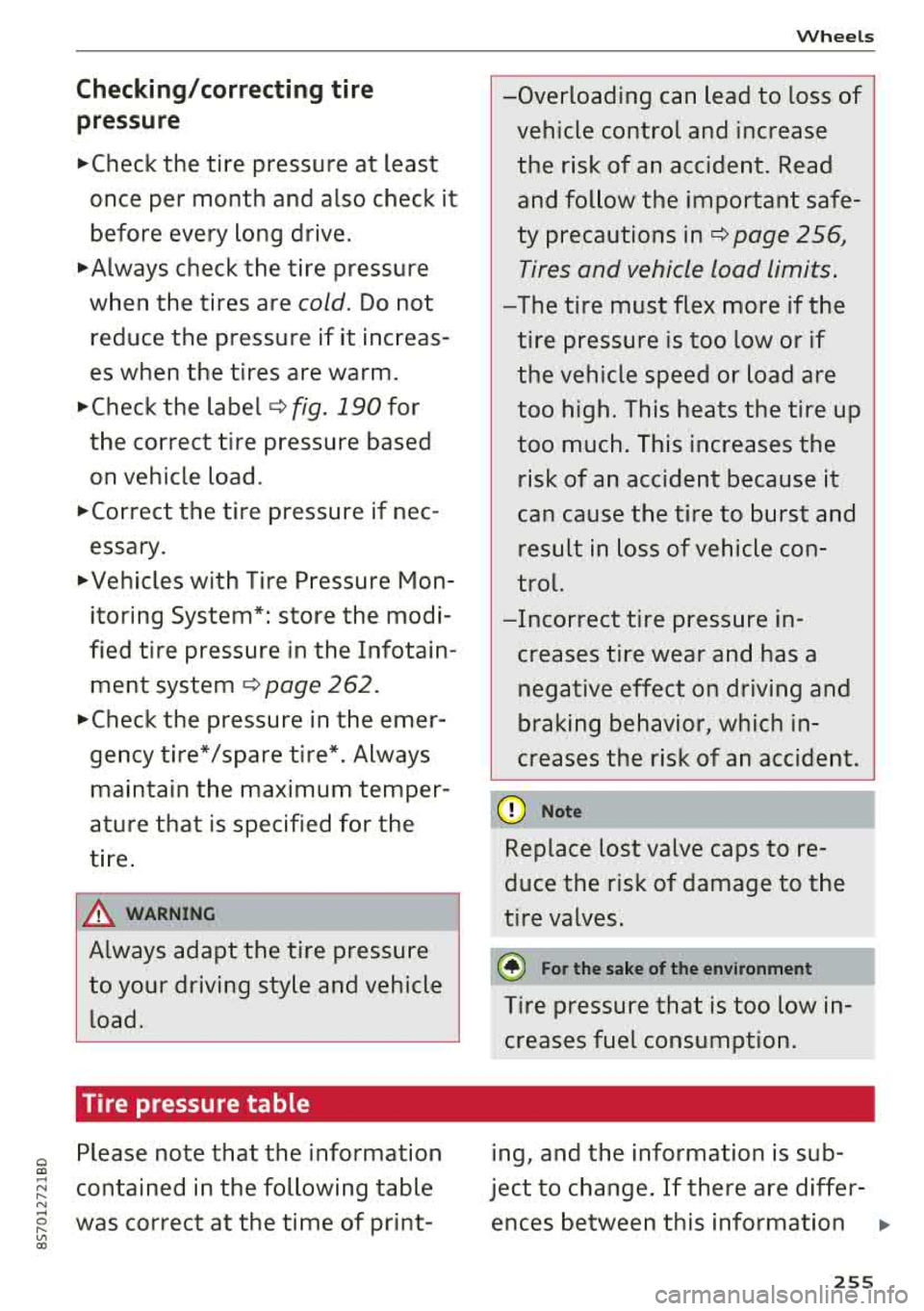
0 co .... N
" N .... 0
" "' co
Checking/correcting ti re
pressure
.,,. Chec k the tire pressure at least
once per month and also check it before every long drive.
.,,. Always check the tire pressure
when the tires are
cold . Do not
reduce the pressure if it inc reas
es when the tires are warm.
.,,. Check the label c:> fig . 190 for
the correct tire pressure based on vehicle load .
.,,.Correct the tire pressure if nec
essary .
.,,.Vehicles with Tire Pressure Mon
itoring System*: store the modi
fied tire pressure in the Infotain ment system
c:> page 262.
.,,. Chec k the pressure in the emer
gency tire*/spare tire* . Always
maintain the maximum temper
ature that is specified for the
ti re .
&_ WA RNIN G
Always adapt the tire pressure
to your driving style and vehicle load.
Tire pressure table
P lease note that the information
contained in the following table
was correct at the time of print-
Wh eel s
-Overloading can lead to loss of
vehicle control and increase the risk of an accident. Read
and follow the important safe
ty precautions
inc:> page 256,
Tires and vehicle load limits .
-The tire must flex more if the
tire pressure is too low or if
the vehicle speed or load are
too high. This heats the tire up
too much. This increases the
risk of an accident because it
can cause the tire to burst and result in loss of vehicle con
trol.
- Incorrect t ire pressure in
creases tire wear and has a
negative effect on driving and
braking behavior, which in
creases the risk of an acc iden t.
@) Note
Replace lost valve caps to re
duce the ris k of damage to the
tire va lves .
@) For th e sa ke o f th e e nvi ro nm ent
Tire pressure that is too low in
creases fuel consumption .
ing, and the information is sub
ject to change. If there are differ- ences between this information
..
255
Page 258 of 310
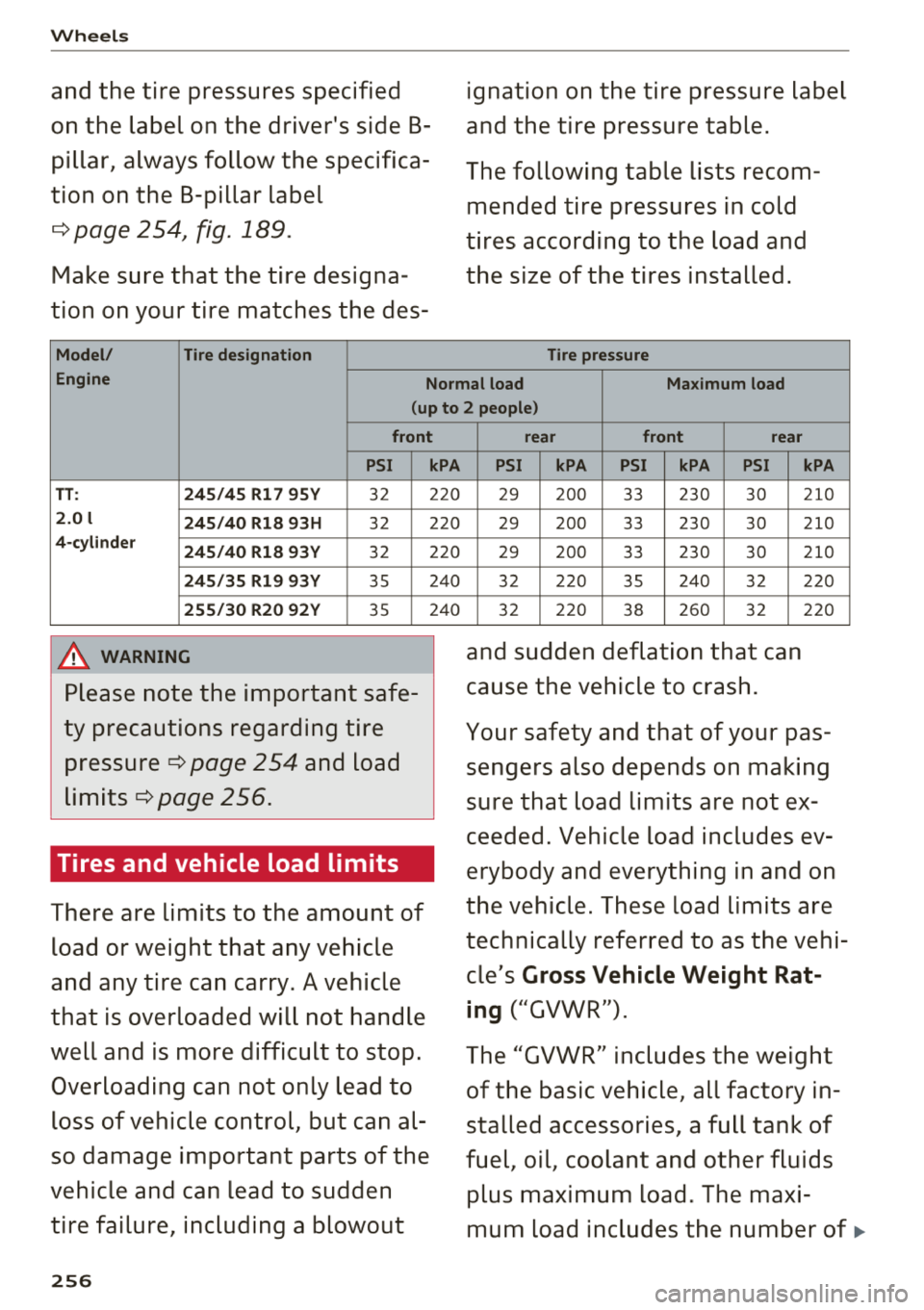
Wheels
and the tire pressures specified
on the label on the driver's side
B
pillar, always follow the specifica
tion on the B-pillar label
¢ page 254, fig. 189.
Make sure that the tire designa
tion on your tire matches the des-
Model/ Tire designation
ignation on the tire pressure label
and the tire pressure table.
The following table lists recom mended tire pressures in cold
tires according to the load and
the size of the tires installed.
Tire pressure
Engine Normal load Maximum load
(up to 2 people)
front
PSI
TT : 245/45 R17 95Y 32
2.0 l
245/40 R18 93H 32
4-cylinder
245/40 R18 93Y 32
245/35 R19 93Y 35
255/30 R20 92Y 35
A WARNING
Please note the important safe
ty precautions regarding tire
pressure ¢ page 254 and load
limits¢ page 256.
Tires and vehicle load limits
There are limits to the amount of
load or weight that any vehicle
and any tire can carry. A vehicle
that is overloaded will not handle
well and is more difficult to stop.
Overloading can not only lead to loss of vehicle control, but can al
so damage important parts of the
vehicle and can lead to sudden
tire failure, including a blowout
256
kPA
220
220
220
240
240
rear front rear
PSI kPA PSI kPA PSI
29 200 33 230 30
29 200 33 230 30
29 200 33 230 30
32 220 35 240 32
32 220 38 260 32
and sudden deflation that can
cause the vehicle to crash.
kPA
210
210
210
220
220
Your safety and that of your pas
sengers also depends on making
sure that load limits are not ex
ceeded. Vehicle load includes ev
erybody and everything in and on
the vehicle. These load limits are
technically referred to as the vehi
cle's
Gross Vehicle Weight Rat
ing
("GVWR").
The "GVWR" includes the weight
of the basic vehicle, all factory in
stalled accessories, a full tank of
fuel, oil, coolant and other fluids
plus maximum load. The maxi
mum load includes the number
of .,.
Page 259 of 310
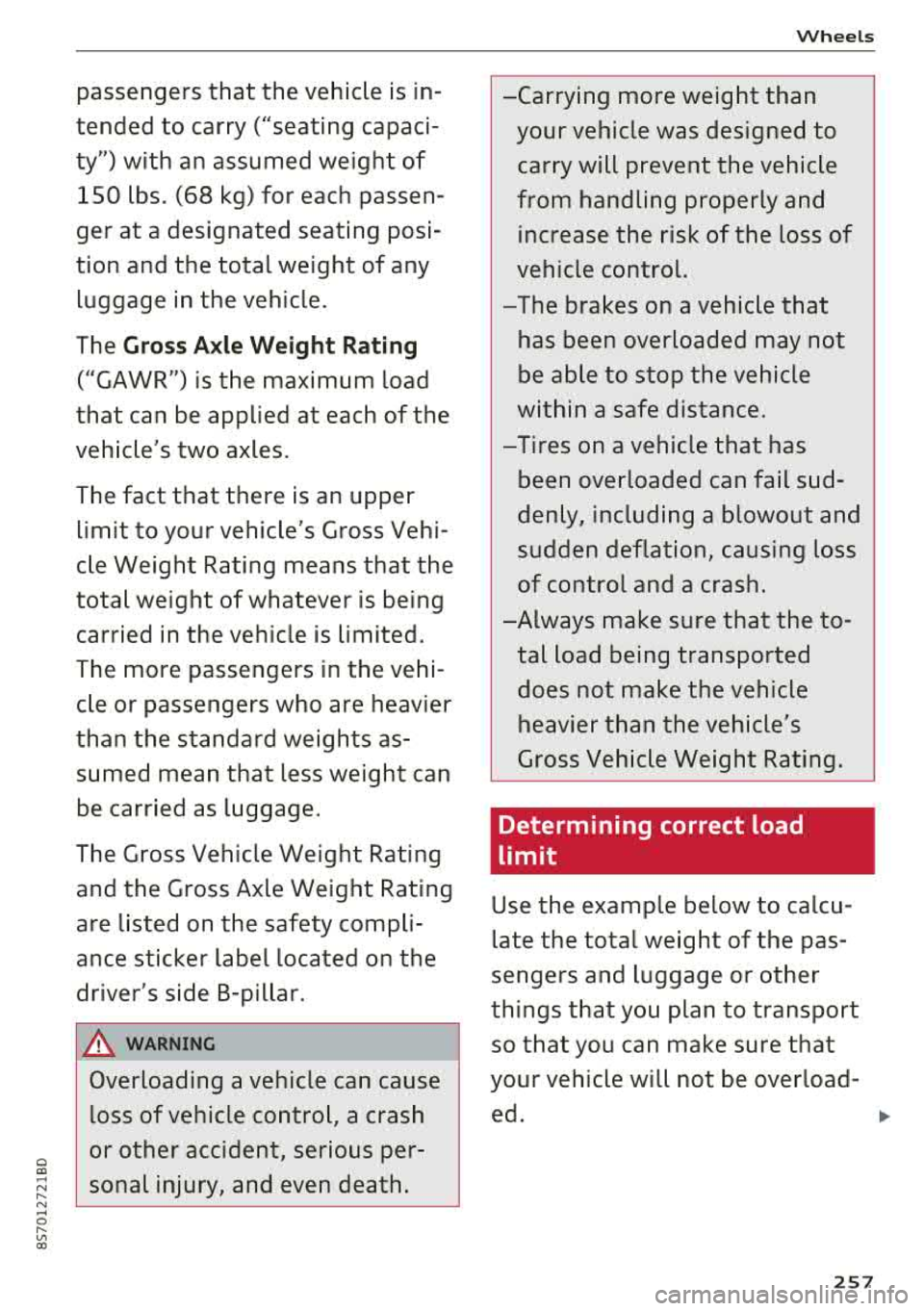
0 co .... N ,.... N .... 0 ,....
"' co
passengers that the vehicle is in
tended to carry ("seating capaci
ty") with an assumed weight of
150 lbs. (68 kg) for each passen
ger at a designated seating posi
tion and the total weight of any luggage in the vehicle.
The
Gross Axle Weight Rating
("GAWR") is the maximum load
that can be applied at each of the
vehicle's two axles.
The fact that there is an upper limit to your vehicle's Gross Vehi
cle Weight Rating means that the
total weight of whatever is being
carried in the vehicle is limited.
The more passengers in the vehi
cle or passengers who are heavier
than the standard weights as sumed mean that less weight can
be carried as luggage.
The Gross Vehicle Weight Rating and the Gross Axle Weight Rating
are listed on the safety compli
ance sticker label located on the
driver's side B-pillar.
A WARNING
-
Overloading a vehicle can cause
loss of vehicle control, a crash
or other accident, serious per
sonal injury, and even death .
Wheels
-Carrying more weight than
your vehicle was designed to
carry will prevent the vehicle
from handling properly and
increase the risk of the loss of
vehicle control.
-The brakes on a vehicle that
has been overloaded may not
be able to stop the vehicle
within a safe distance.
- Tires on a vehicle that has
been overloaded can fail sud
denly, including a blowout and
sudden deflation, causing loss
of control and a crash.
-A lways make sure that the to
tal load being transported
does not make the vehicle
heavier than the vehicle's
Gross Vehicle Weight Rating.
Determining correct load
limit
Use the example below to calcu
late the total weight of the pas
sengers and luggage or other
things that you plan to transport
so that you can make sure that
your vehicle will not be overload-
ed.
~
257
Page 260 of 310
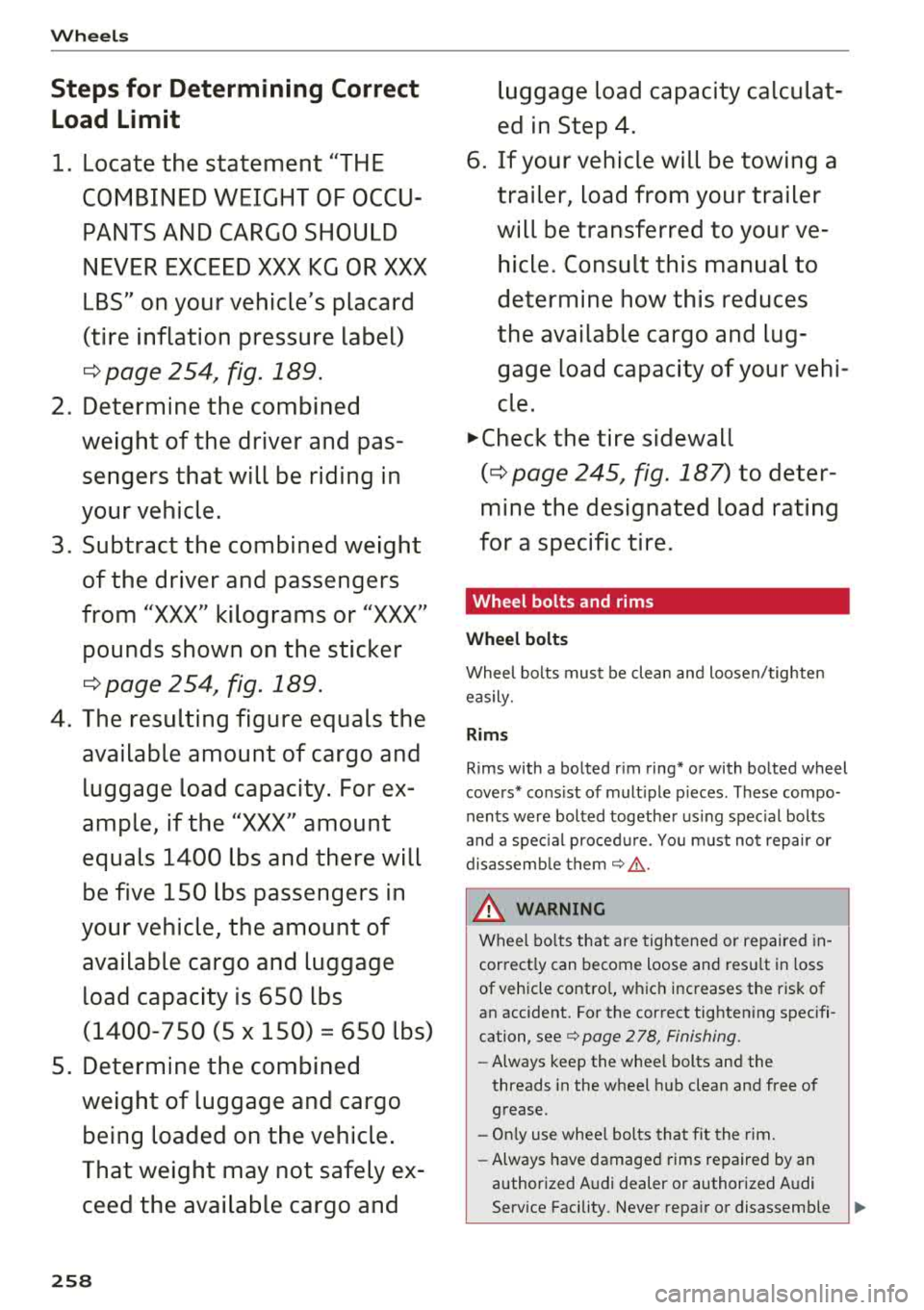
Wheels
Steps for Determining Correct Load Limit
1. Locate the statement "THE
COMBINED WEIGHT OF OCCUPANTS AND CARGO SHOULD
NEVER EXCEED XXX KG OR XXX
LBS" on your vehicle's placard
(tire inflation pressure label)
c:> page 254 , fig. 189 .
2. Determine the combined
weight of the driver and pas
sengers that will be riding in
your vehicle.
3 . Subtract the combined weight
of the driver and passengers
from
"XXX " kilograms or "XXX"
pounds shown on the sticker
c:> page 254 , fig. 189 .
4. The resulting figure equals the
available amount of cargo and
luggage load capacity. For ex
ample, if the
" XXX" amount
equals 1400 lbs and there will be five 150 lbs passengers in
your vehicle, the amount of available cargo and luggage load capacity is 650 lbs
(1400-750 (5
X 150) = 650 lbs)
5 . Determine the combined
weight of luggage and cargo
being loaded on the vehicle.
That weight may not safely ex
ceed the available cargo and
258
luggage load capa city cal culat
ed in Step 4.
6. If your vehicle will be towing a trailer, load from your trailer
will be tran sferred to your ve
hicle. Con sult thi s manual to
determine how this reduces
the available cargo and lug
gage load capacity of your vehi
c le .
~check the tire sidewall
(c:> page 245 , fig. 187) to deter
mine the designated load rating
for a spe cifi c tire.
Wheel bolts and rims
Wheel bolts
Wheel bolts mus t be clea n and loose n/tighte n
e asi ly.
Rims
Rims with a bo lted r im ring* o r with bo lted wheel
covers* cons ist of mult iple pieces . These com po
nen ts were bol ted togethe r using s pec ial bol ts
a nd a s pecial proc edur e. Yo u m ust no t rep air or
d isa sse mble th em
¢ & -
_& WARNING
Wh eel bolts th at are tig hte ned or re paired in
cor re ctly can be come loose and resu lt in los s
of ve hicle contro l, wh ic h increases the risk of
an accident. For t he cor rec t tighten ing s pec ifi
cation,
see¢ page 27 8, Finishing.
- Always keep the wheel bolts an d the
threads in the w heel h ub clean an d fre e of
greas e.
- On ly us e whee l bolts tha t fit th e rim.
- Always h ave damage d rims repaire d by an
auth orized Audi dealer or auth orized A udi
S erv ice Facility. Neve r repa ir o r disassemb le
~